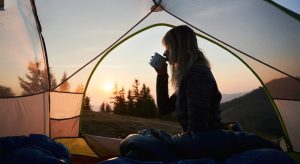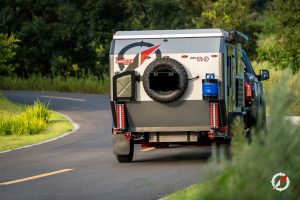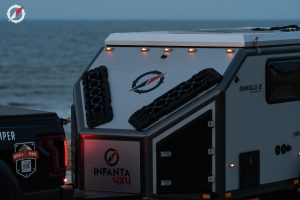We’re going to kick this one off with what I think is just the biggest game changer for me in my camping overlanding journey — and that’s a 12-volt fridge.

These things are so awesome to have. No more having to deal with ice — ice taking up space in, you know, as far as volume goes to keep food and drinks in, soggy food, you know just dealing with all the sloshing and stuff. Especially for those who invest the money in the really nice ice chests like the Yetis, the Artics, you know, the big roto-molded things. You can get some cheap ones at Walmart but you know what I’m talking about.
You can find a fridge for a very similar amount of money. I mean they just—they come in all different sizes and shapes and dual zones and single zones. You can find a fridge that will fit your needs and probably your budget as well.

This one is a 55 liter. I really like this fridge a lot. It’s by Iceco. It’s the APL55. It’s one of those convertible ones where you can have a single zone or a dual zone. I really like it because I can keep all my drinks and stuff cold, all my food, and I love having popsicles at camp. That’s been my new go-to for snacks. You can’t do that with an ice chest — you can’t take popsicles, you can’t take ice cream, you can’t take frozen meats for a longer trip. So these are awesome.
So a 12-volt fridge — totally worth it. Absolute game changer.
Up next on the list are propane fire pits. Now, if you travel out west in the summertime, you’re very likely going to be traveling in areas with burn bans that will not allow any type of campfires. So that’s where these come in super handy. They come in all different shapes and sizes. We’ve got two — one a bigger one — this is the Trail Fire Grill. We love this one because not only is it a great fire pit but it also comes with a grate and you can throw a pizza stone on here. It comes with a lid that can serve as kind of a wok, and so this is not only a good fire pit but it’s also a great cooking tool. So anything that can have multi-purpose is great.
You’re not going to get a bunch of people around this getting warm, but for one or two people, this thing’s great and it packs up really small. Everything fits inside the can, got the nice lid that goes on it and packs up very small, which is handy. This one you can run off a five-pound propane bottle for a couple nights. This one, if you’re going to take a big one, you’re going to need a 10 — probably a 20-pound propane bottle to really crank this up and get some heat out of it, because they do run through propane pretty fast.
But I mean, if you’re traveling in any place with burn bans, these are a must. Totally worth it.

Up next, continuing on with the fire pit theme — these pop-up fire pits are incredible. Ever since getting this a number of years ago, I hate using the ground fire rings. They’re just — they’re dirty, you don’t know what else is in them, and they don’t burn a nice clean fire.
These first of all pack up really small. Just comes in this little bag — smaller than most camp chairs. And what it does is it elevates the fire up off the ground. It has a stainless steel mesh screen on the bottom, which allows airflow to come in from the bottom, which makes a very hot, very clean-burning fire with very little smoke. And so from just enjoying a campfire kind of thing, these things are totally worth it.
Another great thing about these is there’s an optional grate that you can get for the top of these to turn this into a grill and cook off of it. That’s really handy too. I don’t like having fires in the ground fire pits anymore. I won’t use them. I’ll just take this — then you can have a fire, you don’t have to have a fire ring, you can just make a campfire anywhere. Really handy. Totally worth it.
Up next on my list of overlanding/camping gear that is worth the money — diesel heater.
Now I know we are just getting into the middle of the summertime here and it’s already hot down here in the South — it’s getting real sticky. But for winter camping, these things have been so incredible. They’re very efficient, they draw very little power, they use very little diesel. The little tank that comes in this can last us easily two, sometimes even three nights, depending on how high we run it.
But we have camped in sub-freezing temperatures, down to 20 degrees with this thing and stayed warm and cozy up in the tent. Just, you know, sleeping in our underwear, just a very thin top blanket, and got six inches of snow outside. So these things are incredible. Highly worth it.
But yeah, as far as the size of these — they come in kilohertz… kilowatts. Kilowatts. We’ve had a two-kilowatt — it is perfect for a rooftop tent. It’s not perfect for a larger space, so that’s why we now have the five-kilowatt. And this thing will get really warm really fast.
So if you are the type to, you know, pack up your camping gear or just take a whole bunch of sleeping bags and pile under the blankets and stuff when you’re camping and you get out of your sleeping bag and then you’re freezing — give the diesel heater a shot. They legit work and they are totally worth it Up next, if you are going out for extended periods of time on your trips, highly recommend some sort of auxiliary power solution to keep that fridge running, to keep that diesel heater running, to keep all your stuff charged so that you don’t have to worry about it.
Power stations are great — I love them, I recommend them — but they have their quirks for when you’re out traveling, as far as keeping them charged, that sort of thing. An auxiliary power system you can put somewhere under seats — for me, in the back of the bed of my Gladiator, for my wife in the back of her Wrangler — it’s just kind of a set it up, forget about it, and you don’t ever have to worry about whether or not you’ve got enough power unless you’re just not moving for, you know, a week.
It can be done very economically. For my setup, I’ve got two 100 amp hour lithium iron phosphate batteries back there in the back of the Gladiator. If you see there in the very back with that little black with the red stripe — that is my Redarc BCDC1250 charger. So anytime I’m driving, that thing is cranking out 50 amps to charge these batteries super fast. So I never have to worry about whether or not these batteries are charged and whether or not they are working to keep my fridge — my refrigerator — running. My refrigerator stays in the back of my Gladiator full time, constantly running, and I never have to worry about it.
Right next to that is the Renogy 2000 watt pure sine inverter, so I can run just about anything I need at camp. I’ve got little extensions that come up here so I’ve got my power right up here in the front of the bed. But this system right here — then of course I’ve got USB outlets in the side of my Jeep, one 12-volt there, I’ve got one 12-volt there along with switches — so all of my aux lighting (excuse the back of my Gladiator, I am in tent transition right now, so I sold my previous tent, I have a new tent on the way — so forgive this), but all my aux lighting here for the back of the Gladiator runs off this system. And I’ve even got power that runs up into my tent so I never have to worry about power when I’m out on the trail, and that is a huge relief.
And that’s the reason why — you just don’t have to worry about it.
In the back of my wife’s Wrangler, we’ve got a smaller setup. We’ve got two 50 amp hour batteries — so 100 amp hours total — powered off of a Renogy DC to DC, I think also a 50 amp charger. So never has to worry about power. I’ve got auxiliary outlets here for both USB-A and C, 12-volt for fridges, for diesel heaters — all of that set up there. And she doesn’t have to worry about it.
Up next on the list is a satellite communications device, like either the Garmin inReach — this is the Garmin inReach Mini, that’s the original, not the brand new one — or the ZOLEO. Now we have both of these, and these are awesome because, you know, when we’re out off the grid, we most of the time don’t have cell signal, and sometimes you need to communicate back at home and be able to send a text to check in with your wife, your kids, your husband, your parents, whatever.
And that’s where these things come in super handy. They work — they’re sometimes slow — but they work. And when you don’t have cell signal, sometimes you just got to check in on somebody or let someone know that you’re okay, and that’s what these are for. These are also great for if something goes catastrophically wrong and you need help, you need to be rescued, you need to be recovered, you know — if things go horribly bad.
Both of these have SOS functions. The Garmin, just pull that out right there, push that button, and it sends the signal for help to come. Same thing with ZOLEO — right underneath there is the SOS button. This is one of those things where you need to have it and you hope you never have to use it, because if you can’t get help when you’re in one of those situations — I mean — very literally could be the difference between life and death.
So some form of satellite messaging communications device like the ZOLEO or the Garmin inReach.
Now we prefer the ZOLEO. This is the one that lives in my wife’s rig. This is mine. I plan on changing very soon to the ZOLEO because one advantage that this has over this one when it comes to text messaging is — this has a dedicated number. So if something goes wrong at home and my wife or a parent or a kid needs to contact me in an emergency — with this, they can. With this, I have to establish texting first, because it does not keep an assigned number.
Now the last thing on my list for overlanding and camping gear that’s actually worth it — the camp lights.
This is legit the best camp light I have ever used, and I’ve used quite a few. What it is — it’s this little light right here that comes with a telescoping pole, which allows you to raise the light up I think up to nine feet tall, so it gets the light way up high, spreads the light around camp.
And it’s the most incredible camp light I’ve ever seen.
You’ve got — this is it — it’s got four LED lights around the edge.
You can push the button again and change it to just two, so if you just need to light half your camp or if you want to save, you can do it times and only have one light activated.
And you can even hold down the button and you can dim the light down so it’s not as bright. It’s just an incredible light. You can take it off, and so you can — it’s got a little loop in here — if you need to hang it from something, you can. If you’re working on your vehicle and you need a light to shine up to see what you’re working at, you can do it like that. You can just set it on a table like that and have light like this around your table. It’s an incredibly versatile light.
They’ve got options for them such as the filter kit. It comes with three different filters — I’m using the amber on mine — helps with the bugs. That’s another thing these things are great at. With this, you know bugs are drawn to light, even if you’ve got the amber covers on, bugs are still going to be drawn to it to an extent. And so you take this and you put it way up high, just away from camp, so it’s still lighting up your camp, but the bugs are going to be drawn to this instead of you, and it’s a game changer.
I actually had this out on a recent camping trip and the bugs were swarming around the light so bad that when I went to bed I didn’t even venture over there. I just let — to turn this off — I just let it die. I just let it run all night long because I was not going into that swarm that was around the light. And that’s not too bad of a deal because these charge with USB-C and they charge really fast. So that’s an upgrade compared to the original Light Rangers — they now have USB-C charging and much faster charging.
Investing in the right overlanding and camping gear can transform your outdoor adventures, offering convenience, safety, and comfort. From a 12-volt fridge that keeps food fresh without ice to propane fire pits that comply with burn bans, these tools solve common camping challenges. A diesel heater ensures warmth in freezing conditions, while auxiliary power systems keep devices running off-grid. Satellite communicators like the Garmin inReach or ZOLEO provide critical safety nets, and versatile camp lights enhance visibility while minimizing bugs. Whether you’re a weekend camper or a long-haul overlander, these innovations are worth the investment for a seamless, enjoyable experience in the wilderness.
